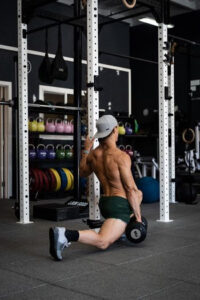5 Ways to Build Functional Muscle
When I go deeper on a topic through writing or making a video, I always learn new things – do you? The opportunity to reach and teach you is a valuable way for me to evolve my thinking further.
So I’m revisiting a topic I addressed several weeks ago after I followed that with a four part workout series for Youtube on Functional Muscle. In these videos on Leg Day, Glutes & Hips, Back, and Chest, I broke down training concepts and formats in even more ways than the original article. (I’ll link those workouts below if you missed them.)
Today I’m covering what you need to know about Functional Muscle, as well as practical tips you can apply right away to build more functional muscle for yourself or people you train.
A Better Definition of Functional
“Functional” is a term so loosely used in fitness. Many people like to limit the concept of function to what life demands of us. But nowadays I see most people spending most of their life sedentary, so we certainly need to raise our standard of function.
Function lies in the shapes and actions our bodies are designed to make. We can define all the positions that our anatomy is capable of making. Maintaining those shapes, or reclaiming those positions with training, enhances our FUNCTIONAL capacity. Two examples are as follows.
- Our bodies are designed to squat ass to grass (ATG Split Squat and Cyclist Squat)
- Our bodies are designed to reach overhead pain free (Behind the Neck Press)
Therefore, if we want to age with all of our movement capacities, and be able to fully express ourselves physically then you want to adopt a Functional Muscle Approach – even if you’re focused on physique.
3 Energy Systems You Need
Our 3 energy systems are also central to being functional. They supply the energy we need to do different types of work:
- Creatine Phosphate – Short bursts of strength
- Anaerobic – 15-90 sec of high power unsustainable work
- Aerobic – 90sec + of sustainable work, that can last hours
Unload the groceries. Run for the bus. Commute to work by bike or on foot. Life will present demands that require short bursts of strength or power, and longer demands of sustainable effort. A Functional Muscle approach to training will allow us to engage in the full spectrum of work demands in life (and sport).
5 Keys to Maintaining Functional Muscle

The good news is that to build and maintain Functional Muscle, you don’t have to change everything about your training style. Put these principles to work, and I’ll also show you some tips for different training scenarios.
- Emphasize Full Range of motion – Strength is gained in the range it is trained. We must continue to train these full ranges of motion if we hope to keep them for a long time.
- Movement Pattern Training – Approach training with a movement pattern focus rather than a body part focus. Movement pattern training will ensure you don’t neglect muscle groups and will allow you to maintain your functional anatomical ranges.
- Strength Balance Principle #1 – 360 Joint Training – The front and back of your joints need to be trained evenly. Similar to a movement pattern approach to balance, it is also important to look at training movements that support all sides of your joints.
- Strength Balance Principle #2 – Work Unilateral Strength by training one side of the body at a time. This will also surface underlying imbalances that you can then work to even out.
- Balance your Energy System Training – Cardio is NOT going to ruin your gainz! But you will need to use it with purpose and pace sustainably.
Tips for Different Training Scenarios
CrossFit Class Tip
Be the uncommon pacer in the class. Rather than going FOR TIME and pushing your speed to the max, consider one to two days a week where you really dial in your sustainable pacing and train for a more AEROBIC energy system effect. This means slower, steadier efforts instead of blowing up in round 2.
Globo Gym Lifting Routine
Be the uncommon unilateral trainee. Add more Structural Balance to your lifting. If you typically do 4 exercises per body part, then make an effort to choose 1-2 exercises each session that target unilateral movements. Need ideas? Search the Functional Bodybuilding Youtube demo video library for any movement you would typically do bilaterally (Bench Press, Squat, etc.), and you’ll find tons of unilateral variations with different ways to load.
Home Gym Session
Be the uncommon full-body trainee. In a fitness world that is overrun with talk of training splits and body part focus, consider an approach that is full body each day at home. Use the movement pattern approach and select one exercises per movement pattern each day, and be sure to execute to a full range of motion.
- Press – Strict Press, KB Push Press, Dumbbell Incline Chest Press
- Pull – Pull Up, Body Row, Dumbbell Row
- Squat – Goblet Squat, Split Squat, Lunge, Back Squat
- Hinge – Deadlift, Good Morning, Hip Thrust
- Core – Sit Up, Plank, Twist
Give these ideas a try and let me know what you learned.
More Resources

Look Good. Move Well.
Workouts for sculpted arms and a six pack are different than those for speed and power. Get my blend of both and a sample nutrition plan. Plus a Big Bicep Bonus for my favorite arm finishers!
